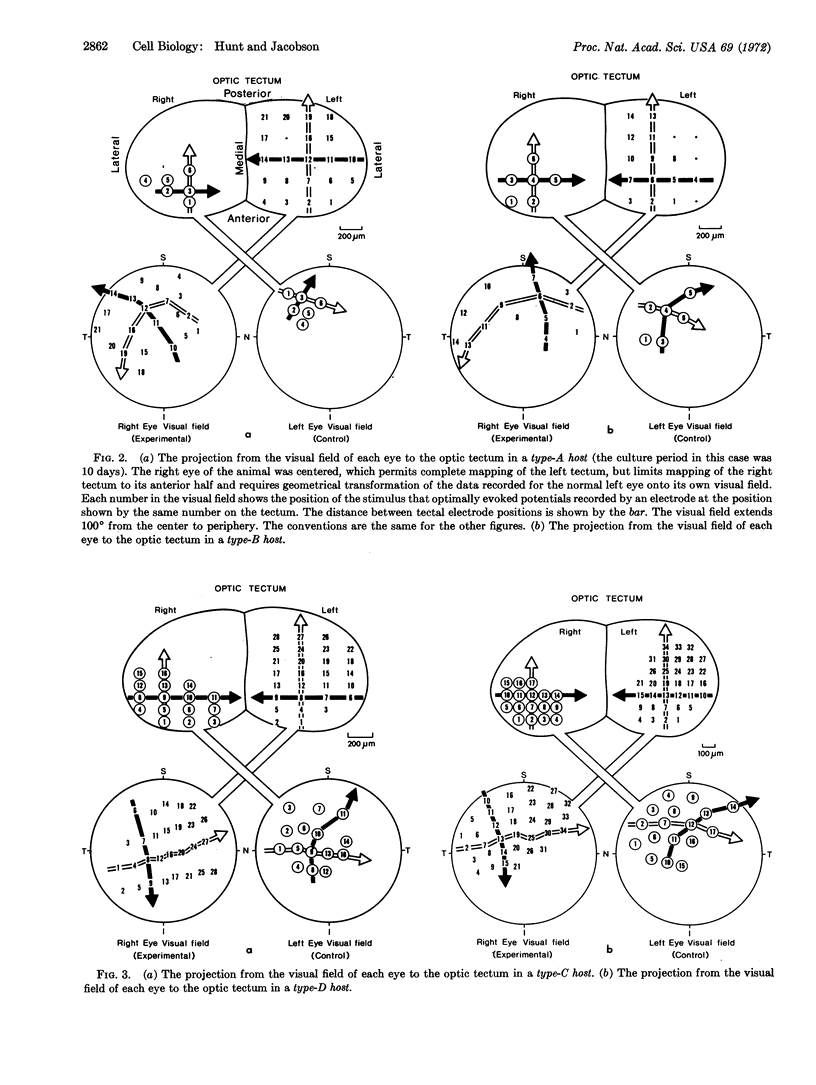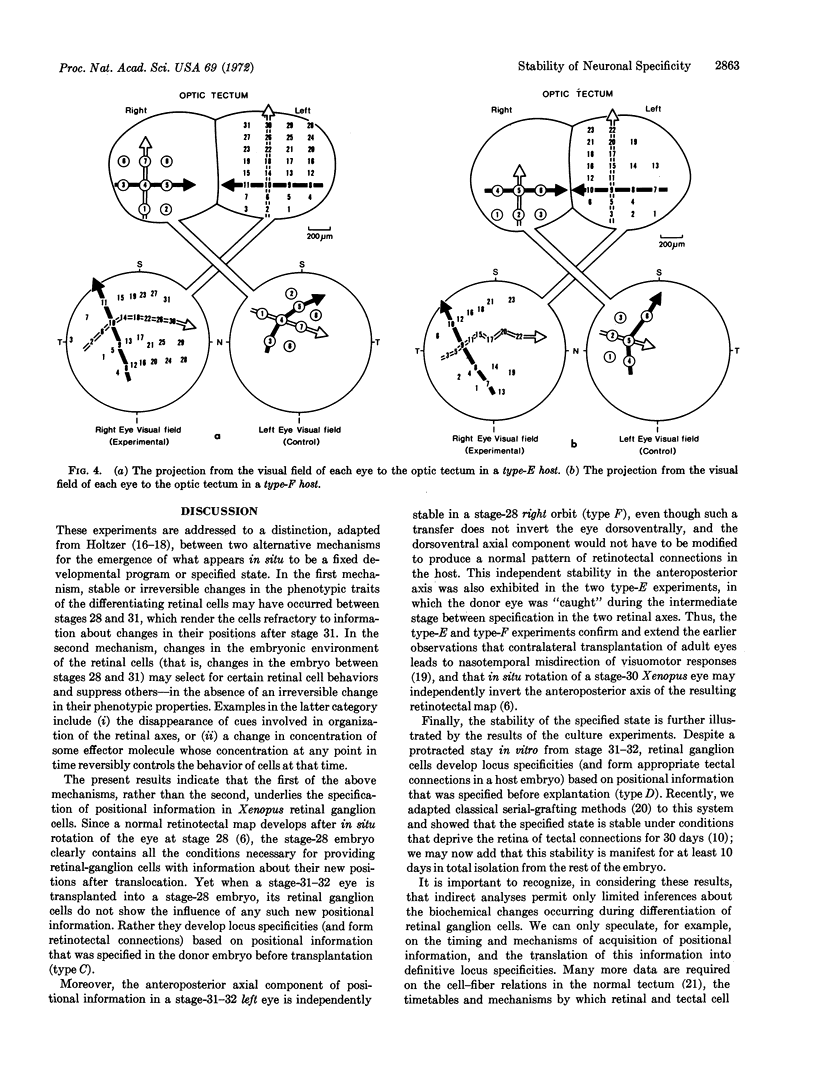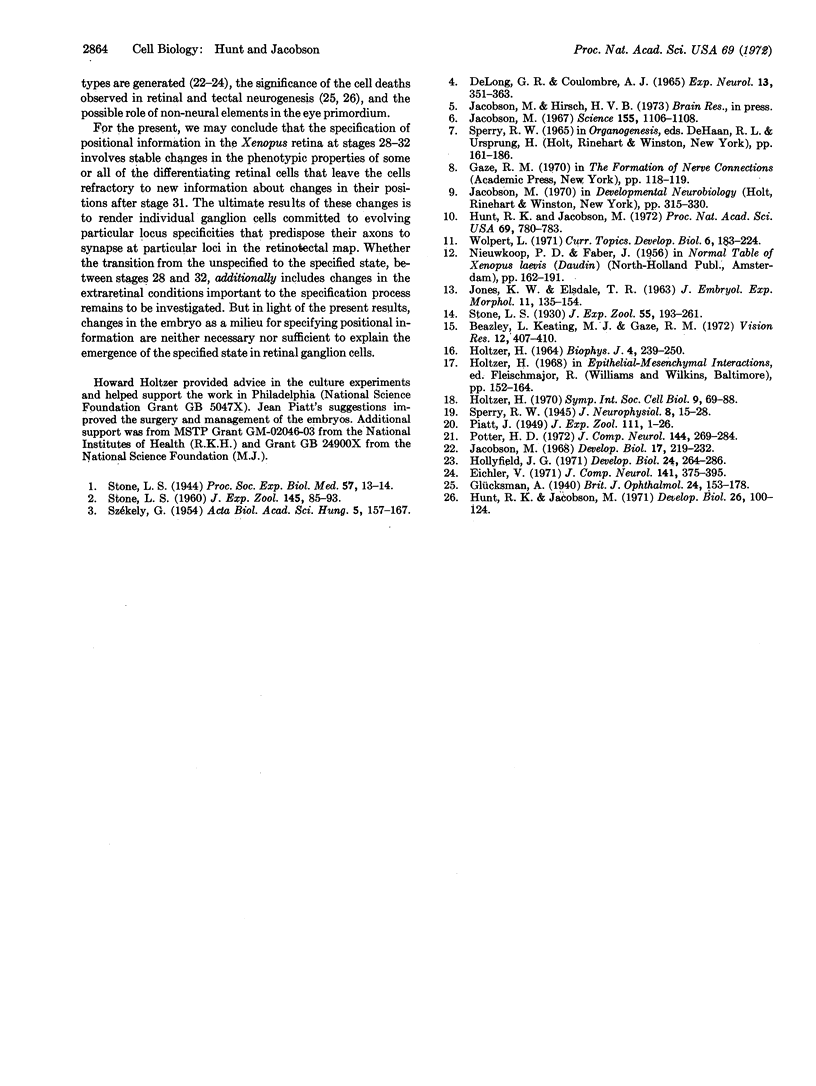Abstract
In the normal development of retinotectal connections, the site in the tectum at which an optic fiber synapses is related to the position of its ganglion-cell body in the retina. How and when the ganglion cells acquire information about their positions is unknown, but the positional information that each ganglion cell will ultimately act upon is determined or specified at embryonic stages 28-32 in the clawed frog, Xenopus laevis. Here we report that once positional information has been so specified, it remains stable when the eye is “back-grafted” into the orbit of a stage-28 host, or cultured in vitro for up to 10 days before grafting into the orbit of a stage-38 host. Thus, the ganglion cells of these eyes form tectal connections appropriate to their original positions in the donor orbits and independent of their final positions in the host orbits. We conclude that specification of positional information involves stable changes in the phenotypic properties of the differentiating retinal cells that (i) render the cells refractory to information about changes in their positions after stage 32 and (ii) commit each ganglion cell to the development of a unique property (locus specificity) that predisposes its axon to synapse at a particular locus in the retinotectal map.
Keywords: neuronal specificity, retinotectal connections, eye transplantation
Full text
PDF




Images in this article
Selected References
These references are in PubMed. This may not be the complete list of references from this article.
- Beazley L., Keating M. J., Gaze R. M. The appearance, during development, of responses in the optic tectum following visual stimulation of the ipsilateral eye in Xenopus laevis. Vision Res. 1972 Mar;12(3):407–410. doi: 10.1016/0042-6989(72)90085-5. [DOI] [PubMed] [Google Scholar]
- De Long G. R., Coulombre A. J. Development of the retinotectal topographic projection in the chick embryo. Exp Neurol. 1965 Dec;13(4):351–363. doi: 10.1016/0014-4886(65)90124-x. [DOI] [PubMed] [Google Scholar]
- Eichler V. B. Neurogenesis in the optic tectum of larval Rana pipiens following unilateral enucleation. J Comp Neurol. 1971 Mar;141(3):375–395. doi: 10.1002/cne.901410307. [DOI] [PubMed] [Google Scholar]
- Glücksmann A. DEVELOPMENT AND DIFFERENTIATION OF THE TADPOLE EYE. Br J Ophthalmol. 1940 Apr;24(4):153–178. doi: 10.1136/bjo.24.4.153. [DOI] [PMC free article] [PubMed] [Google Scholar]
- HOLTZER H. CONTROL OF CHONDROGENESIS IN THE EMBRYO. Biophys J. 1964 Jan;4:SUPPL239–SUPPL255. doi: 10.1016/s0006-3495(64)86941-1. [DOI] [PMC free article] [PubMed] [Google Scholar]
- Hollyfield J. G. Differential growth of the neural retina in Xenopus laevis larvae. Dev Biol. 1971 Feb;24(2):264–286. doi: 10.1016/0012-1606(71)90098-4. [DOI] [PubMed] [Google Scholar]
- Hunt R. K., Jacobson M. Development and stability of postional information in Xenopus retinal ganglion cells. Proc Natl Acad Sci U S A. 1972 Apr;69(4):780–783. doi: 10.1073/pnas.69.4.780. [DOI] [PMC free article] [PubMed] [Google Scholar]
- Hunt R. K., Jacobson M. Neurogenesis in frogs after early larval treatment with somatotropin or prolactin. Dev Biol. 1971 Sep;26(1):100–124. doi: 10.1016/0012-1606(71)90111-4. [DOI] [PubMed] [Google Scholar]
- Jacobson M. Cessation of DNA synthesis in retinal ganglion cells correlated with the time of specification of their central conections. Dev Biol. 1968 Feb;17(2):219–232. doi: 10.1016/0012-1606(68)90062-6. [DOI] [PubMed] [Google Scholar]
- Jacobson M. Retinal ganglion cells: specification of central connections in larval Xenopus laevis. Science. 1967 Mar 3;155(3766):1106–1108. doi: 10.1126/science.155.3766.1106. [DOI] [PubMed] [Google Scholar]
- Potter H. D. Terminal arborizations of retinotectal axons in the bullfrog. J Comp Neurol. 1972 Mar;144(3):269–284. doi: 10.1002/cne.901440303. [DOI] [PubMed] [Google Scholar]
- Wolpert L. Positional information and pattern formation. Curr Top Dev Biol. 1971;6(6):183–224. doi: 10.1016/s0070-2153(08)60641-9. [DOI] [PubMed] [Google Scholar]



